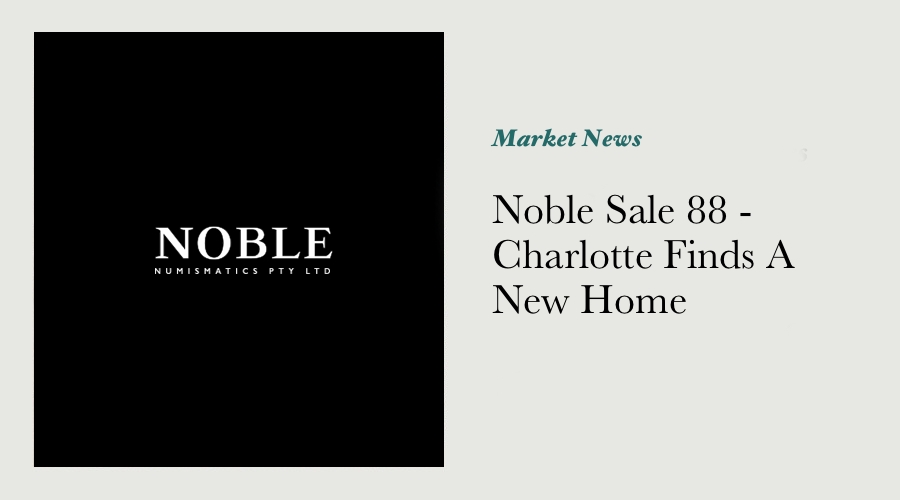Noble Sale 88 - Charlotte Finds A New Home

The most recent Noble Numismatics sale was a record event by any measure – the famed Charlotte medal, engraved by the convict Thomas Barrett, was hammered down for an unprecedented $750,000, which including the 16.5% buyer's premium, ensures that the end price for the successful bidder was a cool $873,750.
I understand that those lucky to be resident in or visiting the Emerald City in the next month will have the opportunity to view the very first item of decorative art produced in Australia at the National Maritime Museum at Darling Harbour by the end of the month.
The Maritime Museum representative fortunate enough to be delegated the task of executing the winning bid was promptly inundated by media representatives as soon as the hammer fell, and he exited the auction room rather promptly. This wasn't easy to do when every available seat was taken, and the outside aisles were packed with journalists and cameramen.
From my position in the front row on the left hand side of the room, I could see that there appeared to be at least one mail bid lodged with the Melbourne representative of Noble Numismatics, and that Jim Noble also executed a bid on behalf of a client via telephone. This shows that it was not a foregone conclusion for a public collection to obtain the medal, and reflects the level of regard this item has within the general public, much less the numismatic community.
I don't recall coming across one person at the event who didn't acknowledge that the medal had an air of gravitas that more recently produced collectibles can ever achieve. There certainly is something unique about the appeal that an exclusive and valuable heirloom from our colonial era has, particularly when it comes with a provenance tracked back to a specific person from the era. I know this is why many collectors are compelled to build a full set of the proclamation or colonial era coinage.
The former owner of the Charlotte medal, the retired dentist Dr Chapman of Melbourne, certainly was a keen student of the Australian historical medal series, and had a definite eye for quality. It wasn't until I had some quiet time in the auction room itself to look through the catalogue and examine Dr Chapman's entire collection did I spot a few medals I wish I'd seen earlier. Commemorative medallions share much of the heritage that many of our most important numismatic items have – not only were they produced by the same mints or manufacturers as many coins were, but they commemorated the same historic events. I believe that a well-rounded coin collection covering any period of Australia's numismatic history can be complemented by a few well-selected commemorative medals.
The medals struck by the machinery brought to Australia by the staff of the (failed) Kangaroo Office come to mind, as do those struck by the Sydney Mint for presentation to dignitaries and staff, as well as those struck by the Perth Mint marking the centennial of white settlement in WA.
Although it would be fair to say that the sessions in the balance of the Noble sale had a somewhat lighter attendance than in months previous, the verdict on the market certainly isn't all doom and gloom. I noticed that bidding by the many eBay resellers that have entered the market in recent years was more subdued, reflecting the hit to disposable income that the average Australian collector has endured in the past year or so. The average price of key date Commonwealth coins in average circulated condition (1925 penny, 1932 florin etc etc) seems to have also at least plateaued as a result. In my opinion, much of the spending in this segment of the market comes from individuals more interested in speculating on “junque” that provides a sniff of a quick return rather than accumulating assets over the long-term.
The next level of the numismatic market is probably for top quality material priced up to the low thousands – items such as this are acquired by reasonably serious collectors that are indeed interested in building a quality collection over the long term. Demand in this segment of the market can be restricted by increased living expenses or other lifestyle pressures, however as most collectors (and I say most!) are level headed spenders that manage their money reasonably well and aren't into hock for tens of thousands of dollars, they can ride out a hiccup in the market, or even worse. Take a stroll through the prices realized for this level of the market and you'll see that it is holding up quite well – there might not be quite the same number of buyers in the market that there was 12 months ago, but there are still more than enough buyers out there.
Strangely enough, the upper level of the market can be inhabited by both kinds of buyers - those that stretch themselves a fair way in order to get ahead, and those that don't need to. I've found that the most accessible rarities are often bought by buyers that are in and out of the market as their broader portfolio demands. Dedicated collectors with good levels of available funds are still in the market no matter what is going on in the broader economy, and it's this segment of the market that I can see may, may, be hit if the broader economy takes a further turn for the worse. What do I mean by this? I can see that the growth for a few of the more popular rarities may ease up if they are continually pushed by new buyers coming into the market. Interesting days eh!